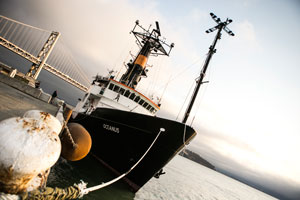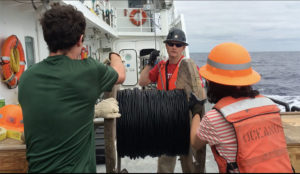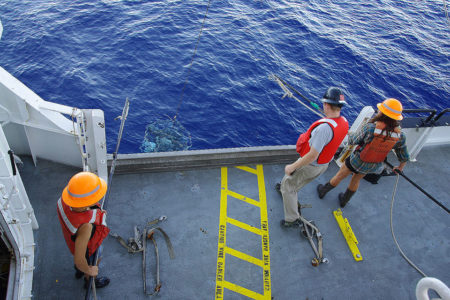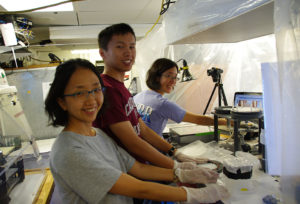 The Oceanus tied up at Pier 30-32 in San Francisco at 7:20 a.m. on Tuesday, Aug. 23, and we are still getting our land legs back. The time at sea has ended, but the work to compile and analyze the data collected is just beginning.
The Oceanus tied up at Pier 30-32 in San Francisco at 7:20 a.m. on Tuesday, Aug. 23, and we are still getting our land legs back. The time at sea has ended, but the work to compile and analyze the data collected is just beginning.
The researchers will look for clues about the seasonality of plankton populations in waters off the coast of California. And the engineers will continue to update the functionality and design of the robotic floats as ocean monitors of the biological carbon pump.
 The crew of the Oceanus (Photo: Kelly J. Owen)To get data from the ocean, it takes a village. That village includes a highly trained support crew on the ship to make sure the science team members can perform their research without undue risk to life or limb.
The crew of the Oceanus (Photo: Kelly J. Owen)To get data from the ocean, it takes a village. That village includes a highly trained support crew on the ship to make sure the science team members can perform their research without undue risk to life or limb. We are nearing the end of this 10-day research trip, and as I’m writing, people are bustling around me in the process of deconstructing the labs they set up and packing up their gear. Researchers have made backup copies of the data collected from the various tests conducted, the Carbon Flux Explorers are tucked away in their crates, 700 meters of cable were unspooled from the ship’s winch back onto a reel by hand, and filtering and processing stations – including the “Bubble” – have been taken down.
We are nearing the end of this 10-day research trip, and as I’m writing, people are bustling around me in the process of deconstructing the labs they set up and packing up their gear. Researchers have made backup copies of the data collected from the various tests conducted, the Carbon Flux Explorers are tucked away in their crates, 700 meters of cable were unspooled from the ship’s winch back onto a reel by hand, and filtering and processing stations – including the “Bubble” – have been taken down.  Outside the California Current, the last few experiments are being run aboard the Oceanus at a place Jim Bishop calls “Oceana Incognita.” The nickname came about because the location feels like the middle of nowhere and has not been observed by satellites for the past six weeks.
Outside the California Current, the last few experiments are being run aboard the Oceanus at a place Jim Bishop calls “Oceana Incognita.” The nickname came about because the location feels like the middle of nowhere and has not been observed by satellites for the past six weeks. Setting up and organizing the various lab spaces take up a large proportion of the time spent loading a ship. Phoebe Lam’s “Bubble” and Jim Bishop’s clean air-water filtration station are examples of spaces that the researchers need to ensure that the samples they collect are not contaminated.
Setting up and organizing the various lab spaces take up a large proportion of the time spent loading a ship. Phoebe Lam’s “Bubble” and Jim Bishop’s clean air-water filtration station are examples of spaces that the researchers need to ensure that the samples they collect are not contaminated.